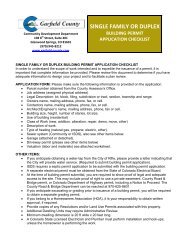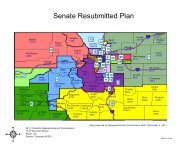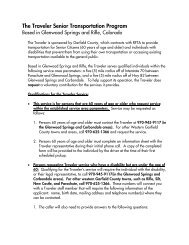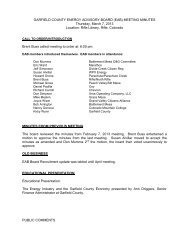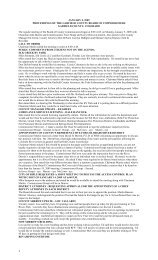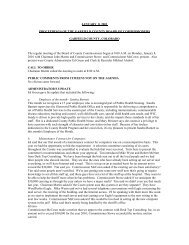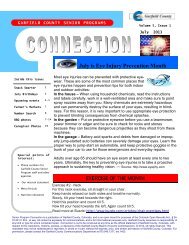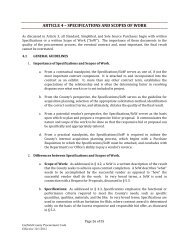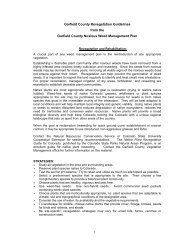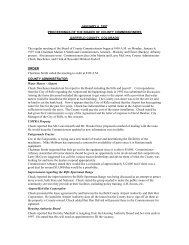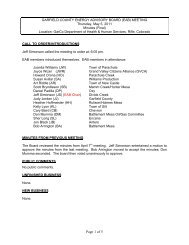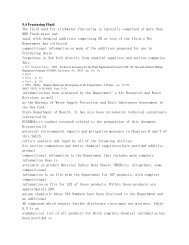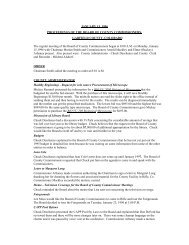Appendix D: Human Health Risk Assessment - Garfield County ...
Appendix D: Human Health Risk Assessment - Garfield County ...
Appendix D: Human Health Risk Assessment - Garfield County ...
You also want an ePaper? Increase the reach of your titles
YUMPU automatically turns print PDFs into web optimized ePapers that Google loves.
<strong>Appendix</strong> D Screening Level <strong>Human</strong> <strong>Health</strong> <strong>Risk</strong> <strong>Assessment</strong> February 2011<br />
Battlement Mesa, Colorado <strong>Health</strong> Impact <strong>Assessment</strong> Colorado School of Public <strong>Health</strong><br />
Group B – Probable <strong>Human</strong> Carcinogen (B1 – limited evidence of carcinogenicity in<br />
humans; B2- sufficient evidence of carcinogenicity in animals with inadequate or lack of<br />
evidence in humans).<br />
Group C – Possible <strong>Human</strong> Carcinogen (limited evidence of carcinogenicity in animals<br />
and inadequate or lack of evidence in humans)<br />
Group D – Not Classifiable as to human carcinogenicity (inadequate or no evidence)<br />
Group E – Evidence of non-carcinogenicity (no evidence of carcinogenicity in adequate<br />
studies).<br />
Weight of evidence classifications for COPCs are provided in Section 4-2.<br />
Cancer risks are expressed as a probability of suffering an adverse effect (cancer) during<br />
a lifetime. They estimate risks to individuals in a population and not to a particular<br />
individual.<br />
For carcinogens, inhalation toxicity measurements are generally expressed as a risk per<br />
unit concentration (e.g., an inhalation unit risk (IUR) in units of risk per µg/m 3 ). The IUR<br />
is based on an upper-bound excess lifetime cancer risk estimated to result from<br />
continuous exposure to an agent at a concentration of 1µg/m 3 in air.<br />
4.1.2 Non-Cancer Toxicity Values<br />
Non-cancer hazards are expressed, semi-quantitatively, in terms of the HQ, defined as the<br />
ratio between an individual’s estimated exposure and the toxicity value. HQs are not an<br />
estimate of the likelihood that an effect will occur, but rather an indication of whether<br />
there is potential cause for concern for adverse health effects. Like cancer risks, HQs<br />
estimate risks to individuals in a population and not to a particular individual (i.e.,<br />
personal risk).<br />
For non-carcinogens, inhalation toxicity measurements are generally expressed<br />
as a concentration in air (e.g., an RfC in units of µg/m 3 air). The RfC is an exposure that<br />
is believed to be without significant risk of adverse non-cancer health effects in a<br />
chronically exposed population, including sensitive individuals.<br />
For non-carcinogens, oral toxicity measurements are generally expressed as a reference<br />
dose (RfD). The RfD is an estimate of a daily chemical intake per unit body weight for<br />
the human population (including sensitive subgroups) that is likely to be without<br />
appreciable risk of deleterious effects during a lifetime.<br />
Chronic RfDs and RfCs are developed to evaluate long-term exposures of 7 years to a<br />
lifetime (70 years), subchronic RfDs and RfCs are developed to evaluate exposures of 1<br />
to 7 years, intermediate RfDs and RfCs are developed to evaluate exposures of >14 to<br />
364 days, and acute RfDs and RfCs are developed to evaluate exposures of 1 to 14 days.<br />
<strong>Appendix</strong> D page 31



